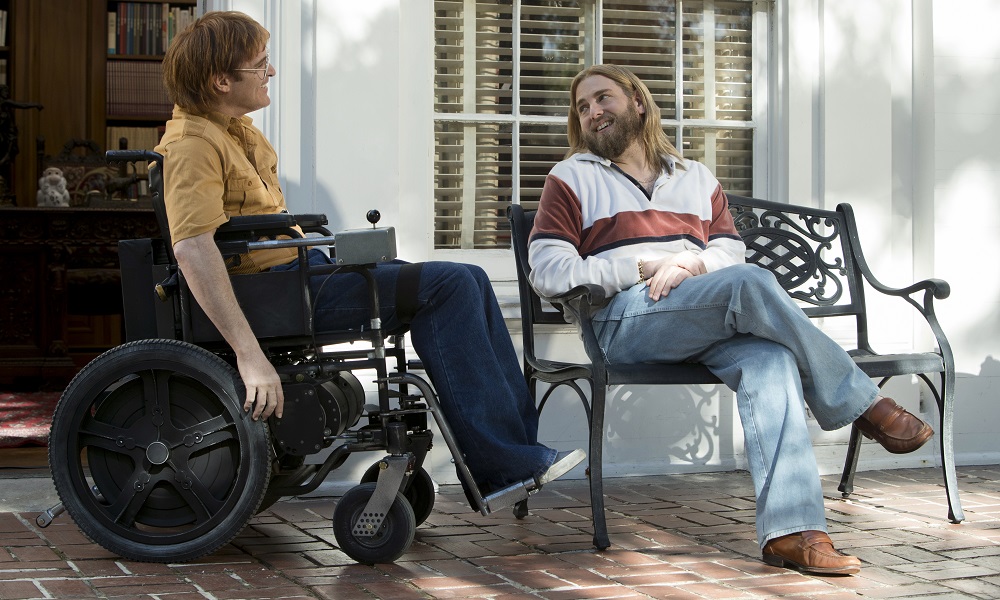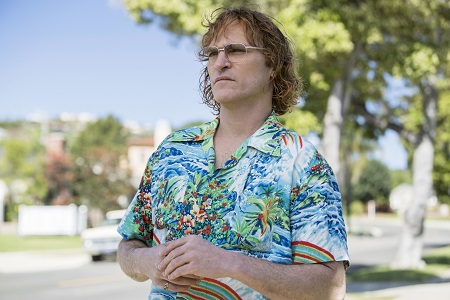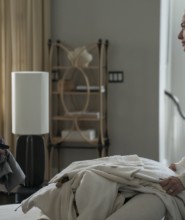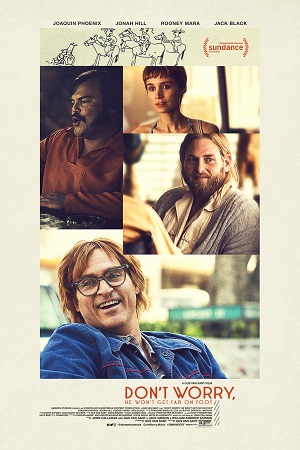
Don’t Worry, He Won’t Get Far On Foot (2018)
by Sara Michelle Fetters - July 20th, 2018 - Film Festivals Movie Reviews
a SIFF 2018 review
John Callahan Bio Don’t Worry an Emotionally Bawdy Celebration
Gus Van Sant’s latest frenzied human drama Don’t Worry, He Won’t Get Far On Foot is perfectly imperfect. Based on portions of the memoir by Portland-based quadriplegic cartoonist John Callahan, the movie is an often anarchic, ribald descent down the addiction and recovery rabbit hole. As melodramatic as that might sound, Van Sant paints with such a sardonically lacerating brush there’s little that ends up coming across as cloying, sophomoric or slight, and even the preachy bits extolling the virtues of following all of Alcoholic Anonymous’ 12 Steps don’t feel anywhere near as didactic or pedantic as they easily could have in a lesser filmmaker’s hands.
But the ace in the hole that the director unleashes with reflectively mischievous brio is star Joaquin Phoenix. Already having a 2018 to remember thanks to his justifiably lauded performance in Lynne Ramsay’s revenge drama You Were Never Really Here, the celebrated actor once again transforms himself in ways that are as brazenly fearless as they are emotionally naked. His turn as Callahan is a maniacal balancing act that runs the gamut of obscene egotistical self-destruction to graceful selfless forgiveness to craven comedic politically incorrect mayhem that never hits a false note. He drops himself inside the controversial cartoonist’s skin with unsettling ease, the ways in which he gave himself over so completely to the character so introspectively massive it’s easy to wonder if he came out of filming without more than a few psychological scars thanks to the experience of doing so.
It’s weird, because even though all of this is derived from Callahan’s best-selling memoir, so much of this story does feel a little like “Cinematic Addiction Melodrama 101.” And yet, if Van Sant isn’t hitting on all cylinders (this is no Drugstore Cowboy or My Own Private Idaho), he’s just close enough to doing so as to give this motion picture a freewheeling devil-may-care meditative ferocity that’s mesmerizing. The majority of the scenes dealing with Callahan’s A.A. experiences happen in a small group setting inside the home of a wealthy Portland trust fund recovering alcoholic named Donnie (Jonah Hill), and these are anything but typical. Van Sant allows them to be a rambunctious celebration of truth, each participant telling their various stories with a vicious candor that’s striking.
These conversations feature constant interruptions, overlapping bits of dialogue and sudden outbursts whenever anyone attempts to stray from the truth that helped fuel their addiction to their particular vice of choice. The actors, a list which includes the likes of a playfully anachronistic Udo Kier, a petulantly forceful Kim Gordon and a gregariously honest Beth Ditto (a celebrated Portland singer and comedian making her movie debut), all command the screen in various ways, Hill lording over them all with a purposefully effete majesty that isn’t nearly as stereotypical or offensive as a viewer’s first impressions of Donnie might initially lead them to surmise. Van Sant digs deep during these conversations, allowing them to slowly break down Callahan’s preconceived walls in a way that makes his eventual breakthroughs far more wrenchingly natural than I expected them to be.
The plot? As nonlinear and as repetitive as it undeniably is, the actual story, even being true, isn’t exactly anything new. The film shows how Callahan went from being a drunken California deadbeat wasting away his life, to a person suddenly finding himself battling for survival in a wheelchair, to an admitted addict aching for recovery, to an unapologetic rabble-rouser who uses his cartoons to provoke newspaper readers into seeing the world through a different, oftentimes objectionable lens. Van Sant captures as much about this portion of this artist’s life as he can, doing so in ways that are as unbridled and as unhinged as the man himself so often proved to be.
It’s explosively emotional, but not all of it works nearly as well as I kept hoping it was going to. Rooney Mara shows up as a Swedish physical therapist who inexplicably makes a career change to become a flight attendant, and this character felt more like a figment of either the director’s or of Callahan’s imagination than it did a living, breathing human being. The early stuff with Jack Black (portraying a Hollywood wannabe playboy whose drunken night of debauchery with Callahan leads directly to his becoming a quadriplegic) is obnoxious in ways that drove me batty, and that’s not a compliment, while the device of having the artist tell the story of his accident to a menagerie of different audiences doesn’t work nearly as well as I’m certain Van Sant intended it to.
But Hill is excellent, delivering one of the best performances of his career. There are also some terrific bits between Phoenix and Sleater-Kinney founding member Carrie Brownstein, portraying Callahan’s beleaguered Portland social worker, that held me spellbound, each moment the two are together building eloquently one upon the one before it in ways that were consistently surprising. As for Black, I cannot discount his performance entirely because there’s a third act reappearance that forced me to look at both him and his character in a whole new light, the actor descending to a level of starkly repentant sincerity that brought tears to my eyes. There’s also some superb camerawork from cinematographer Christopher Blauvelt (Indignation) and a marvelous score courtesy of veteran composer Danny Elfman (Good Will Hunting, Milk), Van Sant allowing both the freedom to put their own idiosyncratic stamp upon the film giving it an extra bit of spontaneity it otherwise would not have had.
Yet it is Phoenix, almost all on his own, who makes Don’t Worry, He Won’t Get Far On Foot something bordering on essential. Working with the actor for the first time since 1995’s To Die For, director and star are in such mutual synchronicity watching them do their thing with such invigorating dynamism is a gripping treat that must be seen to be believed. While not the artist’s whole story from beginning to end, the pair still give this portion of Callahan’s life the agitated bawdy attentiveness it so richly deserves, and in doing so illustrate a freewheeling celebration of recovery, artistic integrity and selfless friendship worthy of applause.
Film Rating: 3 (out of 4)








